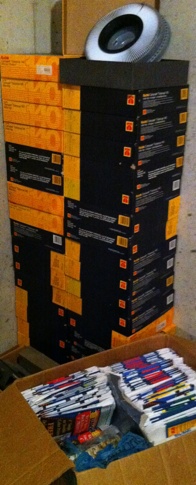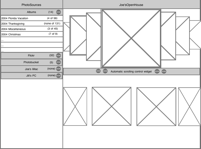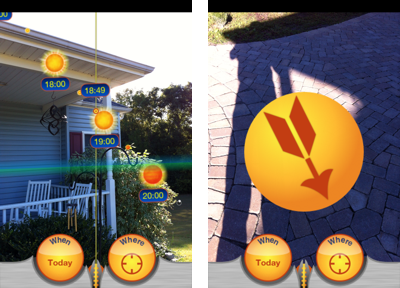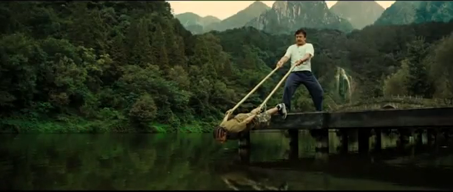Good News and Bad News
Good news — Finding my iOS development rhythm
I have finally managed to get into a good iOS development rhythm over the last several weeks, focusing on my personal iOS projects most of Friday and Saturday, and one or two other evenings during the week. Finding my stride has helped make me much more comfortable in Xcode and the iOS frameworks, and it only takes me a few minutes at the beginning of a session to get back into the flow of iOS.
Bad news — Distractions
Unfortunately, I allowed myself to get distracted from my primary goal for more than a week of that productive time.
Reading a blog post one weekend gave me an app idea I found hard to resist. At first, I was smart. I recorded the idea and some thoughts in my development wiki, and convinced myself to leave it alone. That resolve lasted about three days before I gave in. I deluded myself into thinking I could take the “new shiny” from it’s box and only play with the idea for one evening, but one evening turned into several sessions in a row before I managed to put it back into its box.
I still think the idea has merit, but the allure has worn off enough that it won’t distract me for a bit. (Of course, there is this other idea I just had that will take the app store by storm!)
Current development challenges
My primary goal is developing my photo browser app, and I have prototyped several variations on some ideas I want to incorporate.
I developed a simple wrapper for loading groups and photos using the asset library framework that should be easily extended so I can handle multiple photo sources. I have resisted the urge to build involved hierarchies and large frameworks, and constrained myself to developing some fairly simple protocols. The very basics work now, there are only one or two more features I want to add to the base functionality that my core app needs.
I am currently experimenting with various photo browsing techniques using core animation, and so far it seems promising. This is my first serious use of core animation, so I still have a lot to learn, but @neror’s CA360 project on github has been very useful, as well as Bill Dudney’s Core Animation book published by the Prags.
In typical development fashion, each answered question generates several new questions and problems. I have enough experience to know that most of my problems are the result of limited understanding, misusing a framework somehow, or otherwise doing something stupid.
Some of my current open issues are:
Unexpected pauses in CAKeyframeAnimation
In one of my prototypes I built a single CAKeyframeAnimation animation to move an image across the screen using multiple curve path segments. It pauses slightly at the transition between segments, acting like it takes a small but noticeable amount of time to compute the next segment. I am not comfortable enough with core animation to judge whether I am misusing the framework somehow, or just doing something wrong. Hopefully I will find out this week.
EXC_BAD_ACCESS errors
This evening I encountered EXC_BAD_ACCESS errors in another prototype. I have a very simple framework to handle multi-step animations using blocks which works as expected (except for the EXC_BAD_ACCESS). The EXC_BAD_ACCESS errors occur when accessing values outside the block. I am fairly certain I am creating the blocks correctly, and using them like I have in several other prototypes. But I obviously still have an error, so decided the wisest course was to step away from the code for now and come back to it later this week.
Deciding on best method for photo streams
Several of my experiments have been to help me decide whether core animation is the correct approach for my photo streams. I’d love to let it handle that portion of my app, but I have not gotten far enough to know whether I will be able to use it the way I envision.
What’s next
I am thinking about whether it would be useful to setup a landing page to gauge interest, and if so, how far along I should be in prototyping, experimenting, and customer discovery before I do so. This is all very new to me, so I have continued reading and skimming a lot on the subject. I still need to figure out a way to connect with potential users, but for the moment that is still on the back burner to development experiments.
I am encouraged that as I work on this app, my interest and expectations for it grow. Hopefully I will be able to stay in the flow over the coming weeks and make good progress before 360iDev in Austin. I really want to have a solid core of my app working by then because I know I can get some great feedback from my fellow developers there.
As an indie developer, one of the best things you can do is to find like-minded developers that will provide encouragement and motivation while pursuing a commitment. A great collection of indie iOS developers have helped me stay on track, most of them are either developers associated with iDevBlogADay, or those I have met through the 360iDev conferences. If you can make it to Austin in November, I highly recommend it for its content, the friendships you’ll develop, and the passion it will bring to your iOS development.
Also, here is a little more information about me, Doug Sjoquist, and how I came to my current place in life. You should follow me on twitter and subscribe to my blog. Have a great day!


 I have a confession to make. I take a ton of photos.
I have a confession to make. I take a ton of photos. I first started mocking up something like this at the iPadDevCamp in San Jose last April. The purpose of iPadDevCamp was to show what could be done within the constraints of the existing platform, but since iOS 3.x does not allow access to to photo albums on the device, I shelved the idea. It has now been announced that iOS 4.2 will be available on the iPad, so my idea is viable again.
I first started mocking up something like this at the iPadDevCamp in San Jose last April. The purpose of iPadDevCamp was to show what could be done within the constraints of the existing platform, but since iOS 3.x does not allow access to to photo albums on the device, I shelved the idea. It has now been announced that iOS 4.2 will be available on the iPad, so my idea is viable again.


